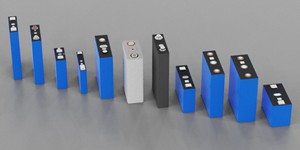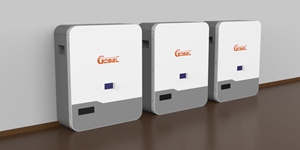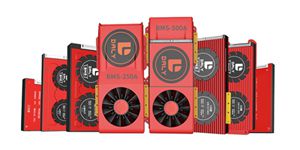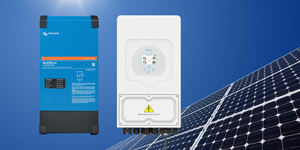LITHIUM BATTERY AND KEY MATERIAL TECHNOLOGY DEVELOPMENT AND JUDGMENT
By Kelly posted 2022-09-30 13:14:03Lithium-ion battery: iron-lithium and ternary have their own strengths, cost reduction and efficiency improvement are the key
General overview: The excellent performance of lithium-ion batteries makes them the best energy storage carriers
Lithium-ion battery refers to a secondary battery (rechargeable battery) that uses lithium as an energy carrier. During charging, lithium ions are extracted from the positive electrode, inserted into the negative electrode through the electrolyte and separator, and the reverse process occurs during discharge, also known as rocking chair battery. Lithium is a solid substance with the highest charge/mass ratio at room temperature, making lithium-ion batteries the energy storage unit with the highest energy density. At the same time, lithium-ion batteries also have long life (cycle life more than 2000 times), high rated voltage (3.2-3.7V), high power bearing capacity (ternary battery can reach 3C charge and discharge capacity), low self-discharge rate, high and low temperature It has the advantages of strong adaptability and green environmental protection. The development of lithium-ion batteries began in the consumer sector and is currently developing rapidly in the power and energy storage sectors.
Power battery: the rapid development of the industry, lithium iron phosphate battery returns to the dominant position in the market
The installed capacity of power batteries in China maintains a rapid growth trend, and the compound annual growth rate will reach 49% by 2025. Driven by the rapid growth of new energy vehicles in China, the installed capacity of power batteries in China will reach 110.1GWh in the first half of 2022, a year-on-year increase of 109.8%. It is expected that the installed capacity will exceed 280GWh in 2022 and 750GWh in 2025. Lithium iron phosphate power batteries have returned to dominance. In the past three years, with the decline of policy subsidies, the advantages of lithium iron phosphate in terms of cost and safety have gradually emerged, the market installed capacity has increased rapidly, and the market share has increased year by year. The share of semi-power batteries increased to 55%.
Energy storage battery: the market is growing rapidly, and large-scale energy storage is the main application
China's energy storage battery shipments maintain a rapid growth trend, with an average annual growth rate of more than 50% in the next three years. In 2021, China's energy storage battery shipments will reach 48GWh, a year-on-year increase of 167%. It is expected that the installed capacity will exceed 90GWh in 2022, a year-on-year increase of 88%, and will exceed 324GWh in 2025. Domestic energy storage batteries are mainly used in large-scale energy storage (power system energy storage), communication system energy storage, household energy storage and portable energy storage. Large-scale energy storage is the main application scenario of energy storage batteries. It is mainly used in energy storage container systems on the power generation side, grid side and user side, accounting for 61% of shipments, followed by communication system energy storage, which is mainly used for communication Base station backup power accounts for 25%, and household energy storage products are mainly exported abroad. Portable energy storage accounted for the least, only 3%.
Large-scale energy storage: developing towards square package and single ultra-large capacity
The installed scale of large-scale energy storage is usually above the MWh level, and large cells are expected to become the mainstream. Large-scale energy storage system is an important facility to promote the large-scale application of renewable energy and build a new power system. It can play the roles of peak regulation, frequency regulation, reserve capacity, smooth output, and alleviation of grid congestion, including energy storage on the power generation side and grid side. , Usually in dozens or even hundreds of MWh, the cells used are mainly large-capacity square cells. In energy storage applications, large-capacity cells of 280Ah and above can effectively reduce the cost of energy storage systems and reduce the difficulty of integration, with obvious advantages. It is gradually replacing the original 50Ah and 100Ah cell products in power storage scenarios.
Household energy storage: Small cells below 100Ah may dominate the field of household storage, and the packaging route has not yet been finalized
Compared with power and large storage, household energy storage has relatively relaxed requirements for cell technology. Household scenarios have relatively low requirements on battery energy density, and the main impact on user experience is the overall product design, including battery management and whole-house energy allocation. The packaging route has not yet been finalized. The scale of the household energy storage system is at the 10kWh level. The large cylindrical battery (single capacity 10Ah-50Ah), square (50Ah-300Ah), and soft pack (30Ah-80Ah) solutions are all selected by the company. There is no set route.
Battery Materials: New Materials Effectively Improve Battery Performance
General overview of battery materials: positive electrode, negative electrode, electrolyte, lithium battery copper foil, separator are the main direct materials of lithium battery
The cathode material is the most important material cost, accounting for about 55%. Lithium-ion batteries are mainly divided into lithium iron phosphate batteries and ternary batteries based on different cathode materials. Both power batteries are available. At present, almost all domestic energy storage batteries are lithium iron phosphate batteries. Anode materials accounted for about 14% of the total cost, including artificial graphite and natural graphite. Artificial graphite can be used in power batteries and energy storage batteries, while natural graphite is mostly used in consumer batteries. The electrolyte accounts for about 13% of the total cost, and its main components are solutes, solvents and additives. Solutes, including LiPF6 and the novel lithium salt LiFSI, are the main cost sources. Solvents are mainly cyclic carbonates and chain carbonates, including PC, EC, DMC, DEC, and EMC. VC, FEC, PS, LiBOB, DTD, LiDFOB, etc.
Cathode material: Lithium iron phosphate production capacity expands rapidly, ternary material capacity expansion is cautious
The supply of lithium iron phosphate will be tight in 2021-2022, the speed of capacity expansion will be accelerated, and there will be structural excess risks in 2023-2025. It is estimated that domestic lithium iron phosphate shipments will be about 950,000 tons in 2022, while the production capacity at the beginning of the year is 940,000 tons, and the product supply is tight. With the rapid release of lithium iron phosphate production capacity in 2023, there is a risk of structural excess capacity. The supply of ternary materials from 2022 to 2025 will be tight, and ternary materials companies will be cautious in capacity expansion. It is estimated that the domestic shipments of ternary materials from 2022 to 2025 are forecast to be 62/88/123/1.70 million tons, respectively, while the production capacity at the beginning of each year is 62/100/125/1.55 million tons respectively, and the supply of production capacity is relatively tight.
Negative electrode material: In the future, the supply of graphite negative electrode will be tight, and the future market prospect will be good
From 2021 to 205, the production capacity of graphite anodes will be relatively tight. The demand for graphite anodes from 2021 to 2025 is expected to be 78/109/146/196/2.7 million tons, respectively, while the production capacity at the beginning of the year was 53/81/133/213/2.59 million tons, respectively. Artificial graphite anode is the mainstream anode material, occupying more than 80% of the overall market share, and the market share is still increasing. Due to the strong downstream demand, the top enterprises are full of production and sales, and some customers have turned to small and medium-sized enterprises, resulting in an increase in the capacity utilization rate of small and medium-sized enterprises, and an increase in the proportion of shipments, resulting in a decline in the market share of leading enterprises.
Electrolyte: There is a risk of overcapacity in the short term, and the industry concentration is high
The scale of newly built electrolyte production capacity is relatively large, and there is a risk of structural excess in the short term. In 2022-2023, the production capacity will expand rapidly and the supply of electrolyte will ease. In 2024-2025, there is a risk of structural excess in corporate production capacity. The electrolyte industry is highly concentrated, with CR3 close to 60%. In 2021, the competition pattern of second-tier enterprises will change greatly, mainly due to the tight supply of upstream raw materials, and some enterprises cannot deliver normally due to insufficient raw materials. The new lithium salt has the possibility of steady improvement in the future. The most widely used new lithium salt is lithium bisfluorosulfonimide (LiFSI).
Lithium battery copper foil: the industry concentration is not high, and the direction of extreme thinning is clear
The demand for lithium-ion copper foil will grow at an average annual compound rate of more than 25% in the future, and there will be a structural excess risk in 2022-2024. With the rapid growth of demand for power batteries, the total shipments of lithium battery copper foil will increase significantly. The market share of CR7 exceeds 60%, and the industry concentration is not high. The market share of CR7 is increasing, indicating that the supply and demand relationship of lithium battery copper foil is basically stable, and it is increasing steadily year by year. The thinning direction of lithium battery copper foil is clear, that is, the energy density of the battery is increased by compressing the volume. At present, 6um occupies the mainstream of the market. A few companies such as Nord Co., Ltd. and Telford Technology have supplied 4.5um copper foil products in small batches to head battery companies. Others such as Longdian Huaxin, Jiayuan Technology, Zhongyi Technology, Tongguan Copper Foils, etc. have also accelerated the pace of R&D and mass production of 4.5um copper foil.
Diaphragm: The equipment technology threshold in the diaphragm industry is the highest, and Enjie shares occupy the leading position of the diaphragm
Separators are divided into wet-process separators and dry-process separators. Wet-process separators occupy the dominant market position by virtue of their advantages such as lightness, thinness, and low self-discharge. The thickness of the wet-processed separator is lower than that of the dry-processed separator, which is beneficial to improve the energy density of the battery. The main advantages of dry-processed separators are low cost, resistance to overcharging and high safety. In 2022, the supply of both dry-process and wet-process diaphragms will be tight, and new production lines of many companies will be put into operation, resulting in a rapid release of production capacity. In 2021, the market concentration of wet-process diaphragms will increase, with TOP3 accounting for 78%, mainly because the new production lines of leading companies in the second half of the year will be put into operation, which will drive the increase in shipments. With the increase in shipments driven by the commissioning of new production capacity, Shanghai Enjie's market share will increase in 2021.
New battery technology: superior performance and effective cost reduction, is expected to seize power and energy storage applications
Sodium-ion battery: low cost, high safety, low temperature resistance and fast charging advantages
Sodium-ion batteries are rechargeable batteries, and the production equipment is compatible with lithium-ion batteries. The sodium-ion battery mainly relies on the movement of sodium ions between the positive electrode and the negative electrode to work. The principle is the same as that of the lithium-ion battery, and the manufacturing process is also similar, so the two battery production equipment are compatible. For sodium-ion batteries, the positive and negative electrodes are replaced with new materials such as sodium salt, hard carbon/soft carbon, respectively, and the negative current collector is changed to aluminum foil.
Sodium-ion batteries have the advantages of low cost, high safety, low temperature resistance, and fast charging, and are expected to seize the energy storage market and entry-level electric vehicle market. Compared with lithium iron phosphate batteries, sodium-ion batteries have 30%-40% lower cost, good safety, high low temperature capacity retention rate of 20pct, and 15min charging of more than 80%, but their energy density is 30Wh/kg lower, and the cycle performance is better than LFP. Low more than 2000 times. Sodium-ion batteries will be applied to the lithium iron phosphate battery application market, reducing the cost of purchasing energy storage and entry-level electric vehicles, and in specific application scenarios such as commercial vehicles, energy storage power stations, 5G communication base station backup power sources, electric two-wheelers and even electric ships. It is expected to replace lithium iron phosphate batteries.
Solid-state battery: With high safety and high energy density, automotive-grade sulfide and oxide solid-state batteries are expected to be the first to be applied
All-solid-state lithium battery is a lithium battery that uses solid electrode materials and solid electrolyte materials without any liquid. All materials exist in solid state, which can greatly improve the high safety and high specific energy of the battery. Each aspect also has certain potential advantages. Sulfide and oxide solid-state batteries can be used as automotive-grade products in the future. Solid-state batteries are mainly divided into three categories according to the electrolyte: sulfide solid-state batteries, oxide solid-state batteries and polymer solid-state batteries. The conductivity of sulfide is very close to that of liquid lithium battery, and the conductivity of oxide is an order of magnitude worse than that of liquid lithium battery, which can be 10%~20%; To 60 ℃ -80 ℃ can be used in micro electric vehicles. At present, the core problem of solid-state batteries is to solve the problems of interface adaptation and stability, and the improvement of comprehensive indicators is still very challenging.
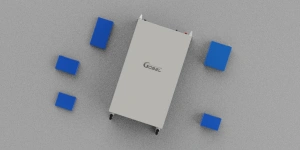
 Europe Warehouse
Europe Warehouse